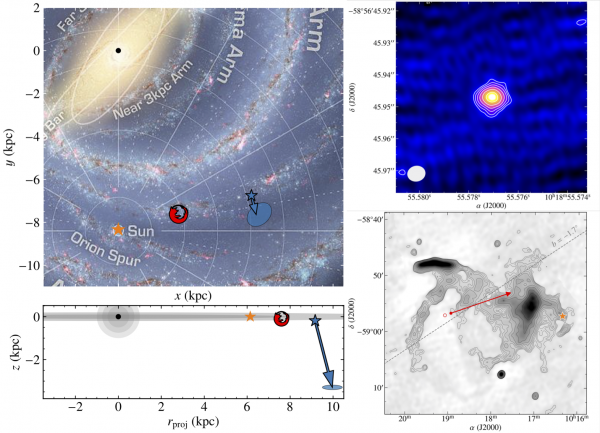
Gamma-ray binaries are extreme and rare objects. Only seven of these systems are known, and it is thought that all of them consist of a very young neutron star orbiting a massive star. The energetic neutron star produces a relativistic wind that collides with the strong, non-relativistic wind of the massive star. Astronomers observe the emission produced by electrons that are accelerated to relativistic speeds during this incredibly powerful wind collision. This emission spans the full electromagnetic spectrum from radio wavelengths up to very high energy gamma-rays.
The neutron star in these systems must have been produced after a supernova explosion. In many cases, it is expected that the leftover of this explosion, the supernova remnant, is still visible. However, the same explosion typically gives a kick to these systems, which then start moving at velocities of up to hundreds of kilometres per second. Thus, associating these binaries to a nearby supernova remnant is challenging, as the systems might have travelled a long way since the explosion.
A team of astrophysicists led by Dr. Benito Marcote (JIVE) has studied one of these gamma-ray binaries, 1FGL J1018.6-5856, with very high resolution radio observations using the Australian Long Baseline Array (LBA) and optical data from the Gaia satellite.
They pinpointed the radio emission to a region smaller than 20 astronomical units (20 times the distance between the Sun and the Earth). These binary systems are expected to show a cometary tail arising from the wind collision and the orbital motion.
The high precision of these data allowed this team to measure the distance, position, and motion of the source with unprecedented accuracy. The 3D motion of 1FGL J1018.6-5856 within our Galaxy has thus been reconstructed. Two important conclusions have been derived from these results: The system is moving away from the plane of our Galaxy with a velocity of ~45 km/s, which is slightly higher than typical; a clue that the supernova explosion affected the system’s velocity. Secondly, the high precision measurements of the binary’s position and velocity disprove a prior theory of an association with existing supernova remnant G384.3-1.8.
In the future, the team plans to image this source with even higher resolution and sensitivity to detail the structure of the radio emission. The planned observations will also show how the cometary tail evolves as the stars orbit each other.
This study appears in the volume 619 of Astronomy & Astrophysics in November 2018 (article number A26, https://www.aanda.org/articles/aa/abs/2018/11/aa32572-18/aa32572-18.html” can be found here) and was led by Benito Marcote from the Joint Institute for VLBI ERIC (JIVE, The Netherlands), Marc Ribó and Josep M. Paredes from the University of Barcelona (UB, Spain), Minnie Y. Mao from the University of Manchester (UK), and Philip G. Edwards from CSIRO Astronomy and Space Science (CASS, Australia).
Contact
Katharina Immer - JIVE Outreach Team
Joint Institute for VLBI ERIC (JIVE)
Email: immer@jive.eu
Phone: +31 521-596 507
Benito Marcote - Lead author
Joint Institute for VLBI ERIC (JIVE)
Email: marcote@jive.eu
Phone: +31 521-596 508
Additional Information
The Australia Telescope Compact Array and the Australian Long Baseline Array are part of the Australia Telescope National Facility which is funded by the Australian Government for operation as a National Facility managed by CSIRO. This work has made use of data from the European Space Agency (ESA) mission Gaia (https://www.cosmos.esa.int/gaia), processed by the Gaia Data Processing and Analysis Consortium (DPAC, https://www.cosmos.esa.int/web/gaia/dpac/consortium).
The Joint Institute for VLBI ERIC (JIVE) is an international institute based in the Netherlands that provides support, conducts leading research and forwards technical development in the field of radio astronomy. Its primary mission is to operate and develop a powerful supercomputer, known as the correlator, which processes data from the European VLBI Network (EVN) - an array of radio telescopes located across the globe.
JIVE is funded by six member countries: the Netherlands, France, Latvia, Spain, Sweden and the United Kingdom; it is also supported by four participating research institutes: the National Astronomical Observatories of China, the Max Planck Institute for Radio Astronomy, the Italian National Institute of Astrophysics and the National Research Foundation. JIVE is hosted at the offices of the Netherlands Institute for Radio Astronomy (ASTRON) in the Netherlands.
Image credits
Images of 1FGL J1018.6-5856 at radio wavelengths and its motion within the Galaxy and with respect to the supernova remnant G384.3-1.8, which is located along the same line of sight from the Sun.
Paper
https://www.aanda.org/articles/aa/abs/2018/11/aa32572-18/aa32572-18.html
Marcote, B., Ribó, M., Paredes, J. M., Mao, M. Y., Edwards, P. G. 2018. Refining the origins of the gamma-ray binary 1FGL J1018.6–5856. A&A, 619, A26
